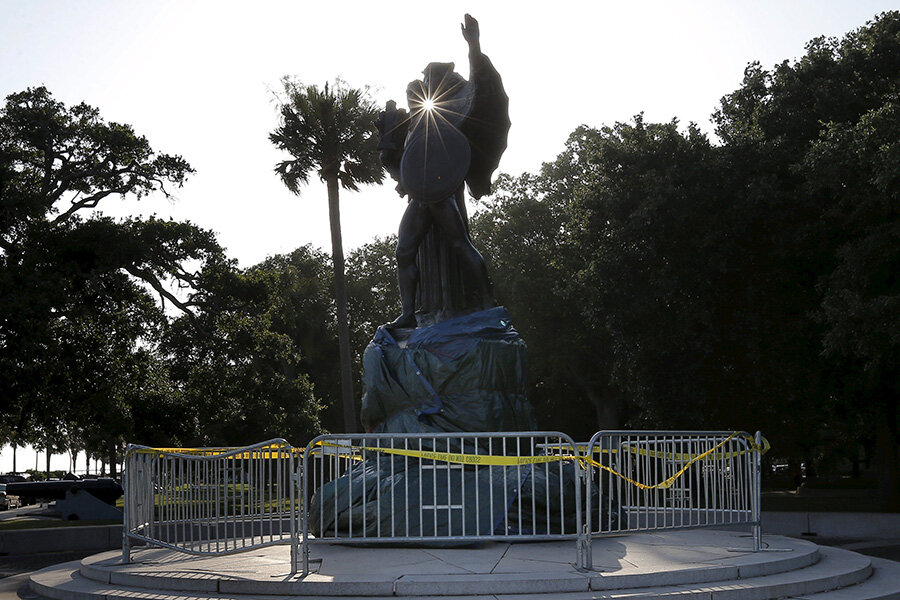Confederate monuments targeted by vandals: Time to rethink memorials?
Loading...
Confederate memorials are under attack, from speeches to petitions to outright vandalism.
Last week, a white supremacist was charged with killing nine innocent black men and women. This week, flags and statues associated with the Confederacy have been tried and convicted before the suspected gunman sets foot in court.
Dylann Storm Roof is accused of opening fire inside the Emanuel African Methodist Episcopal Church in Charleston, S.C., killing nine people. Images of Mr. Roof posing with the Confederate battle flag have surfaced since the deadly attack.
The fact that the Confederate battle flag has remained flying on South Carolina state property at full height has resonated in and outside the state. It has led to a campaign of petitions against the flag and others like it, as well as a spate of vandalism against public monuments to the Civil War. In Mississippi, Republican House Speaker Philip Gunn is calling to remove the Confederate battle emblem from their state flag: "As a Christian, I believe our state’s flag has become a point of offense that needs to be removed."
On Tuesday, officials found that a Civil War memorial in Charleston's Battery had been spray painted with the words, “Black Lives Matter,” while a second historic statue, in a park near Emanuel AME Church, was also vandalized. Red spray-painted letters edited the John C. Calhoun statue in Marion Square, changing "Calhoun" to "Calhoun, racist" and adding "and slavery" to the epigram "Truth Justice and the Constitution." Mr. Calhoun was a prominent champion for slavery in the decades leading up to the Civil War, praising white supremacy and slavery as "a positive good."
Vandalizing Calhoun is nothing new, say historians; the Calhoun statue was defaced so regularly in the 1880s and '90s that the statute was placed on a much higher pedestal to discourage vandals.
Other memorials to the Confederate past are also facing negative attention. In Baltimore, Maryland, "Black Lives Matter" was spray painted in yellow on another statue honoring Confederate soldiers.
In Austin, Texas, students are using a different approach to rid themselves of an unwanted memorial. Hundreds of University of Texas students have signed a petition calling for the university to remove a statue of Jefferson Davis, who was president of the Confederate States of America during the Civil War. "Given Jefferson Davis’ vehement support for the institution of slavery and white supremacy, we believe this statue is not in line with the university’s core values," says the petition.
“It’s times like this when the truth has to fight for its life,” says Ben Jones, former Georgia congressman and spokesman for the Sons of Confederate Veterans (SCV), in an interview. “They are painting us with the broad brush of racism and nothing could be further from the truth. I personally fought the Ku Klux Klan many times and have the very real scars to prove it.”
Mr. Jones refers to the call for the flag’s removal and the vandalism of the statues as attempts at “cultural cleansing” and “revisionist history.”
Revisionist history is not all bad, says Laura T. McCarty, vice president of the Georgia Humanities Council. “In effect, all history is revisionist history, because it is put together after the fact and from a perspective," she writes via email. "Even if you photograph or videotape an event as it happens, you don't get every possible piece of evidence to provide the complete and only account of what happened and why.”
Heidi Beirich, who directs the Intelligence Project for The Southern Poverty Law Center, agrees with Jones on only one point: “It is vandalism. Whether you support or don’t support these Confederate memorials, that’s not the appropriate way to deal with backlash against racism. We shouldn’t be destroying historic things, period."
However, she told the Monitor, “The cause of removing the Confederate battle flag from public property – not historical things, but public property – is legitimate and the right thing to do."
“Frankly, I would say the revisionists that exist are the pro-Confederate groups like the Sons of Confederate Veterans,” Beirich continues. “They’re the ones who are trying to whitewash the history of the Confederacy.”
Jones disagrees. “We’re not whitewashing anything," he says. "We’re honoring our ancestors. We’re not going to feel any different about our ancestors because of these attacks. It’s just going to make them feel bad and stubborn. I know that’s how I’m feeling.”
Historian James Grossman, executive director of the American Historical Association in Washington, D.C., says via email, “ ‘Remembering the Civil War’ has seldom (if ever) been the purpose of public display of the flag.”
“The Confederate flag had very little presence in public life until 1948, and into the 1950s," he writes. It attained prominence as "a reaction to the civil rights movement and federal actions on behalf of the rights of African Americans."
Ms. McCarty, an author and historian, says, “Public memory is shaped by what people learn from their families, in school, as well as what they encounter in public spaces like the media, museums, squares, and capitol grounds."








